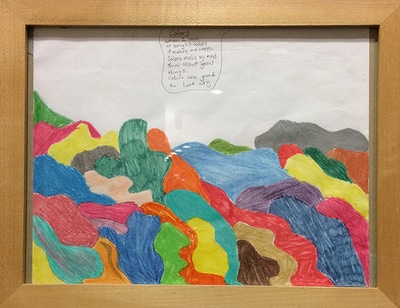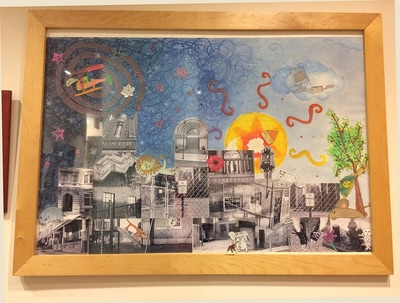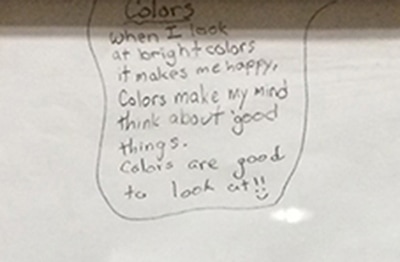The Waiting Room Project, 1998
Jefferson University Hospital
Philadelphia, PA
Collaborative Arts and Science Workshops
Between Patricia Moss-Vreeland and Dr. Gail Edelsohn
The work was produced from a series of progressive workshops, by children from three different schools. The Waiting Room Project and workshops, connected a sense of purpose between space and function, with the main occupants, the children of the waiting area, giving them a sense of belonging.
The waiting room project was to create a transitional space for children, adolescents, families, caretakers, and other adults who are anticipating a psychiatric evaluation or treatment session. In an effort to make the waiting room a more active and engaging space, this project was designed to address the thoughts, feelings, and curiosity of the occupants of this space. The artwork was created by children for this area from a series of workshops led collaboratively by Gail A. Edelsohn, MD. Director, Division of Child and Adolescent Psychiatry, Thomas Jefferson University and artist/author, Patricia Moss-Vreeland in 1998.
The project involved working with students from three different developmental stages, early elementary school (first grade), late latency (fourth grade), and adolescence (high school). The high school students came from both public and private schools, while the elementary students were all from a public city school. The emphasis was on development, that element which makes the entire field of child and adolescent psychiatry so unique, requiring an understanding of health and illness, adaptation and mal-adaptation, all within the context of development. The high school students initially me with Dr. Edelsohn to understand why children, adolescents and adults seek mental health and to discuss how this project will serve those waiting in a sensitive and meaningful way. The high school students also assessed the space to plan appropriate design approaches for the artwork. They evolved into a design team in progressive workshops, working closely with Ms. Moss-Vreeland, while spending time with students in their classrooms.
Dr. Edelsohn met with students to talk about mental health, the brain, mood and behavior and why individuals seek help. Moss-Vreeland worked with them about making these interdisciplinary connections using the arts. They all recognized your feelings can change over time and while waiting, so that your feelings of unease for instance can shift. Their feelings were noted in the course of waiting, could trigger a host of memories.
Jefferson University Hospital
Philadelphia, PA
Collaborative Arts and Science Workshops
Between Patricia Moss-Vreeland and Dr. Gail Edelsohn
The work was produced from a series of progressive workshops, by children from three different schools. The Waiting Room Project and workshops, connected a sense of purpose between space and function, with the main occupants, the children of the waiting area, giving them a sense of belonging.
The waiting room project was to create a transitional space for children, adolescents, families, caretakers, and other adults who are anticipating a psychiatric evaluation or treatment session. In an effort to make the waiting room a more active and engaging space, this project was designed to address the thoughts, feelings, and curiosity of the occupants of this space. The artwork was created by children for this area from a series of workshops led collaboratively by Gail A. Edelsohn, MD. Director, Division of Child and Adolescent Psychiatry, Thomas Jefferson University and artist/author, Patricia Moss-Vreeland in 1998.
The project involved working with students from three different developmental stages, early elementary school (first grade), late latency (fourth grade), and adolescence (high school). The high school students came from both public and private schools, while the elementary students were all from a public city school. The emphasis was on development, that element which makes the entire field of child and adolescent psychiatry so unique, requiring an understanding of health and illness, adaptation and mal-adaptation, all within the context of development. The high school students initially me with Dr. Edelsohn to understand why children, adolescents and adults seek mental health and to discuss how this project will serve those waiting in a sensitive and meaningful way. The high school students also assessed the space to plan appropriate design approaches for the artwork. They evolved into a design team in progressive workshops, working closely with Ms. Moss-Vreeland, while spending time with students in their classrooms.
Dr. Edelsohn met with students to talk about mental health, the brain, mood and behavior and why individuals seek help. Moss-Vreeland worked with them about making these interdisciplinary connections using the arts. They all recognized your feelings can change over time and while waiting, so that your feelings of unease for instance can shift. Their feelings were noted in the course of waiting, could trigger a host of memories.


